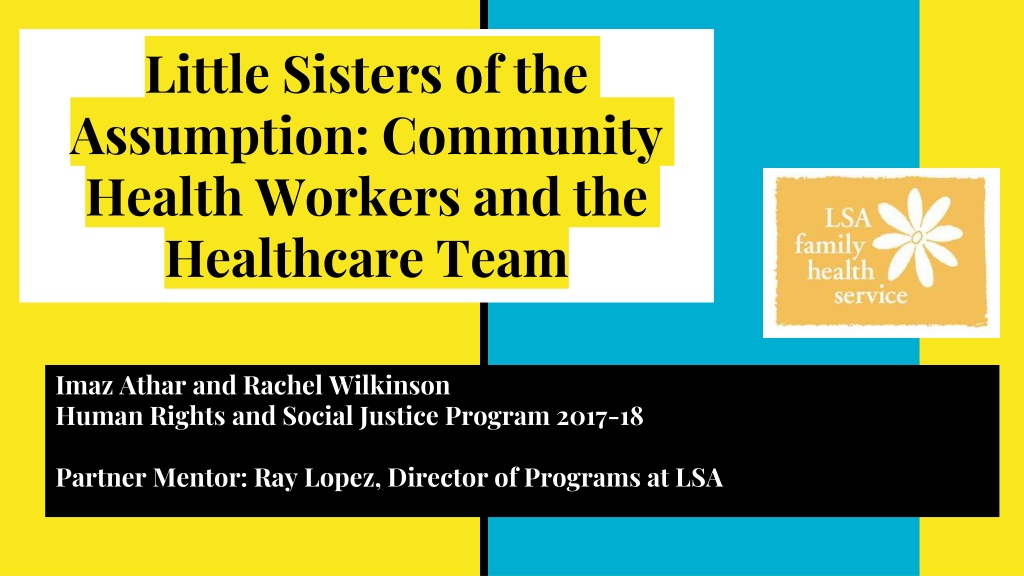Integration of Little Sisters of the Assumption Community Health Workers into Healthcare Teams at Mount Sinai: Research Study
A research study focusing on the integration of Community Health Workers (CHWs) from Little Sisters of the Assumption into healthcare teams at Mount Sinai. The study explores methods such as in-home interventions, education, data sharing, case management, and advocacy to enhance collaboration between CHWs and healthcare providers. Qualitative interviews were conducted with key stakeholders to understand current communication processes and the perceived role of CHWs in healthcare teams at Mount Sinai, particularly in pediatrics and emergency department settings.
Download Presentation

Please find below an Image/Link to download the presentation.
The content on the website is provided AS IS for your information and personal use only. It may not be sold, licensed, or shared on other websites without obtaining consent from the author. Download presentation by click this link. If you encounter any issues during the download, it is possible that the publisher has removed the file from their server.
E N D
Presentation Transcript
Little Sisters of the Assumption: Community Health Workers and the Healthcare Team Imaz Athar and Rachel Wilkinson Human Rights and Social Justice Program 2017-18 Partner Mentor: Ray Lopez, Director of Programs at LSA
Context: Asthma in East Harlem Childhood asthma is a prominent health issue in East Harlem 6th highest rate of child asthma hospitalizations in NYC (2x the citywide rate) Rate of asthma-related ED visits among children in East Harlem is 2.4x the citywide rate (620 vs. 255 per 10,000) Asthma is the leading cause of missed school days Pollution is a major contributing factor 9.7 micrograms per cubic meter air pollution (ranks 16th out of 59 community districts) 76% of renter-occupied homes in East Harlem with at least one maintenance defect (6th out of 59 community districts) Data from NYC Department of Health
Context: LSAs role in East Harlem Little Sisters of the Assumption was founded in East Harlem 1958 Aims to strengthen and empower vulnerable families and children by meeting their basic needs" In 2016: 2,130 families, 7,000+ people served* LSA s Environmental Health Services uses Community Health Worker model to address high rates of asthma in East Harlem *from LSA s 2016 Annual Report
Context: Community Health Worker model What do CHWs do? Remediation, Education, Advocacy CHW model works! Cost-effective Save $1135 per patient per year For every dollar invested in CHW, the hospital system saves $2.30 Positive health outcomes Successful in management of many chronic illnesses 80% of school children in LSA s Environmental Health program had fewer or no urgent care or emergency room visits as a result of asthma Data from ASTHO and LSA
Research Question: How can LSAs CHWs be better integrated into healthcare teams at Mount Sinai? medical services in-home interventions, education data sharing, case management community health workers address basic needs, advocacy, community mobilizing, education, coaching ... clinics households Graphic provided by 2016-17 dyad
Methods Qualitative interviews with Ray, community health workers, and healthcare providers at Mount Sinai - Interviews were recorded and notes were reflected back to participants for feedback We focused on pediatrics and ED providers Key Questions asked: - What is the current process for communicating with CHWs/providers? - How do you view the role of CHWs on healthcare teams? - How could communication between CHWs and providers be improved? - -
Theme 1 - Enthusiasm from providers to learn about LSA Recognized the unmet need for social services that LSA could fill Providers would definitely be interested in working more closely with CHWs and other CBOs we want to hear what the CHWs see in our patients homes and communities We would also like to know more about LSA s other services (food pantry, thrift store, etc.) so we can refer patients there as well. Lack of guidance from department heads and other hospital leadership Excitement about learning from CHWs about their patient s home lives Pediatrician A
Theme 2 - Logistical challenges in the referral process There are a lot of extra steps for a CHW to get in touch with the appropriate social worker, write out the referral, faxing forms, etc. CHWs need a designated point person at the hospital, who could scan paperwork into EPIC for providers. CHWs do not have access to Epic, which is the primary form of communication with physicians Pediatrician B Although physicians want to help patients with their needs, they only see patients for 15 minutes...can t get a social worker involved unless the physician identifies need in the first place. Emergency Medicine physician
Theme 3 - Normalization of poorly managed asthma care We need to talk to patients about the benefits of managing asthma better at home Frequent ED visits have become normal for many families Pediatrician Challenges accessing primary care in the community Many patients are used to coming to the emergency room for asthma exacerbation. Some patients also prefer to go to the ED because they get seen same day. No one gets denied care at the ED, so for some patients coming to the ED regularly is normal for them. Social work
Next Steps Short-term Connecting LSA to interested providers in the ED and pediatrics LSA presentations at faculty meetings, social work meetings, etc. Long-term Explore possibility of integrating a CBO referral component into EPIC Quality assurance study to demonstrate the unmet need for CHW services Potential of new technologies (NOWPOW, Healthix) to improve health communication
Acknowledgments Ray Lopez and Sergio Gonzales at LSA Ann-Gel Palermo and Ray Cornbill 2016-17 Dyad Usnish Majumdar and Sayeeda Chowdhury
Citations NYC Health Community Profiles 2015: East Harlem LSA Family Health Service 2016 Annual Report Association of State and Territorial Officials. Community Health Worker Successes and Opportunities for States. Arlington, VA; 2017. Brown HS, Wilson KJ, Pag n JA, et al. Cost-Effectiveness Analysis of a Community Health Worker Intervention for Low-Income Hispanic Adults with Diabetes. Preventing Chronic Disease. 2012;9(8):1-9. A Community Health Worker Model to Address Childhood Asthma: Perspectives of Program Participants






























